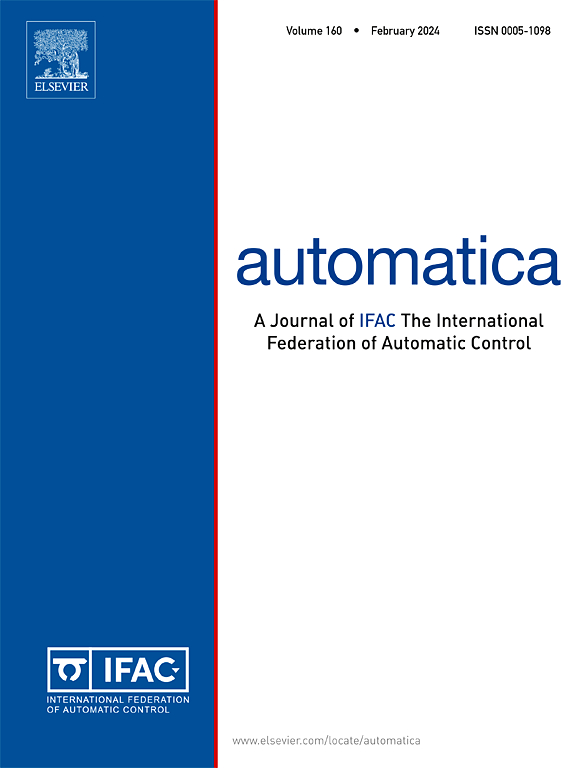具有均衡约束条件的最优控制问题的非内部点延续方法
IF 4.8
2区 计算机科学
Q1 AUTOMATION & CONTROL SYSTEMS
引用次数: 0
摘要
本研究提出了带均衡约束的最优控制问题(OCPEC)的数值方法。由于缺乏约束规则性和严格可行的内部点,求解 OCPEC 非常困难。为了高效求解 OCPEC,我们首先放松离散化的 OCPEC 以恢复约束规则性,然后将其 Karush-Kuhn-Tucker (KKT) 条件映射为参数化方程组。随后,我们使用一种名为非内点延续法的新型两阶段求解方法来求解参数化方程组。在第一阶段,采用非内部点法寻找初始解,该方法使用牛顿法求解参数化系统,并使用专用的优点函数实现全局收敛。在第二阶段,利用预测器-校正器延续方法,从初始解开始,跟踪解轨迹作为参数的函数。所提出的方法对 KKT 矩阵进行了正则化处理,并不强制迭代保持在可行内部,从而减轻了求解 OCPEC 时的数值困难。在某些假设条件下分析了收敛特性。数值实验证明,提出的方法可以求解 OCPEC,同时计算时间明显少于内点法。本文章由计算机程序翻译,如有差异,请以英文原文为准。
A non-interior-point continuation method for the optimal control problem with equilibrium constraints
This study presents a numerical method for the optimal control problem with equilibrium constraints (OCPEC). It is extremely difficult to solve OCPEC owing to the absence of constraint regularity and strictly feasible interior points. To solve OCPEC efficiently, we first relax the discretized OCPEC to recover the constraint regularity and then map its Karush–Kuhn–Tucker (KKT) conditions into a parameterized system of equations. Subsequently, we solve the parameterized system using a novel two-stage solution method called the non-interior-point continuation method. In the first stage, a non-interior-point method is employed to find an initial solution, which solves the parameterized system using Newton’s method and globalizes convergence using a dedicated merit function. In the second stage, a predictor–corrector continuation method is utilized to track the solution trajectory as a function of the parameter, starting at the initial solution. The proposed method regularizes the KKT matrix and does not enforce iterates to remain in the feasible interior, which mitigates the numerical difficulties in solving OCPEC. Convergence properties are analyzed under certain assumptions. Numerical experiments demonstrate that the proposed method can solve OCPEC while demanding remarkably less computation time than the interior-point method.
求助全文
通过发布文献求助,成功后即可免费获取论文全文。
去求助
来源期刊

Automatica
工程技术-工程:电子与电气
CiteScore
10.70
自引率
7.80%
发文量
617
审稿时长
5 months
期刊介绍:
Automatica is a leading archival publication in the field of systems and control. The field encompasses today a broad set of areas and topics, and is thriving not only within itself but also in terms of its impact on other fields, such as communications, computers, biology, energy and economics. Since its inception in 1963, Automatica has kept abreast with the evolution of the field over the years, and has emerged as a leading publication driving the trends in the field.
After being founded in 1963, Automatica became a journal of the International Federation of Automatic Control (IFAC) in 1969. It features a characteristic blend of theoretical and applied papers of archival, lasting value, reporting cutting edge research results by authors across the globe. It features articles in distinct categories, including regular, brief and survey papers, technical communiqués, correspondence items, as well as reviews on published books of interest to the readership. It occasionally publishes special issues on emerging new topics or established mature topics of interest to a broad audience.
Automatica solicits original high-quality contributions in all the categories listed above, and in all areas of systems and control interpreted in a broad sense and evolving constantly. They may be submitted directly to a subject editor or to the Editor-in-Chief if not sure about the subject area. Editorial procedures in place assure careful, fair, and prompt handling of all submitted articles. Accepted papers appear in the journal in the shortest time feasible given production time constraints.
 求助内容:
求助内容: 应助结果提醒方式:
应助结果提醒方式:


